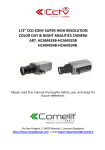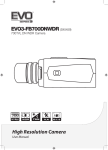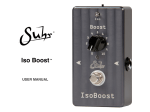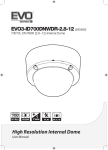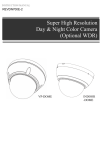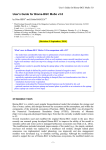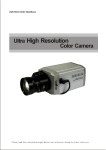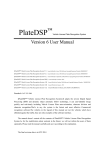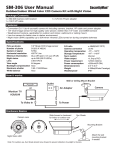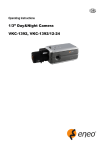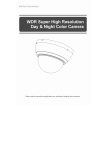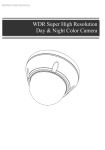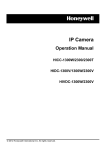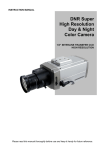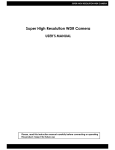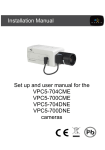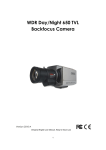Download Protos V 58XWDR
Transcript
Installation Manual Set up and user manual for the VPC5-704DNS VPC5-700DNS cameras Before You Begin Read these instructions before installing or operating this product. Note: This installation should be made by a qualified service person and should conform to local codes. This manual provides installation and operation information. To use this document, you must have the following minimum qualifications: A basic knowledge of CCTV systems and components A basic knowledge of electrical wiring and low-voltage electrical connections Intended use Only use this product for its designated purpose; refer to the product specification and user documentation. Customer Support For assistance in installing, operating, maintaining and troubleshooting this product refer to this document and any other documentation provided. If you still have questions, please contact Norbain Technical Support and Sales: Norbain Ltd 210 Wharfedale Road, IQ Winnersh Triangle, Wokingham, Berks RG41 5TP UK +44 (0) 118 912 5000 / Netherlands +31 (0) 76 579 2577 / Belgium +32 (0) 3 369 8080 South Africa +27 (0) 11 887 1546 / Portugal +351 234 301900 Spain +34 91 503 06 78 Middle East +971 4 881 14332 / Rest of world +44 118 912 5000 Note: You should be at the equipment and ready with details before calling Technical Support. Conventions Used in this Manual Boldface or button icons highlight command entries. The following WARNING, CAUTION and Note statements identify potential hazards that can occur if the equipment is not handled properly: * WARNING: Improper use of this equipment can cause severe bodily injury or equipment damage. ** Caution: Improper use of this equipment can cause equipment damage. Note: Notes contain important information about a product or procedure. RoHS Announcement All lead-free products offered by the company comply with the requirements of the European law on the Restriction of Hazardous Substances (RoHS) directive, which means our manufacture processes and products are strictly “lead-free” and without the hazardous substances cited in the directive. The crossed-out wheeled bin mark symbolizes that within the European Union the product must be collected separately at the product end-of-life. This applies to your product and any peripherals marked with this symbol. Do not dispose of these products as unsorted municipal waste. CE Mark This apparatus is manufactured to comply with the radio interference. A Declaration of Conformity in accordance with the following EU standards has been made. The manufacturer declares that the product supplied with this document is compliant the provisions of the EMC Directive 2004/108/ EC, the CE Marking Directive 93/68 EEC and all associated amendments. * This symbol indicates electrical warnings and cautions. ** This symbol indicates general warnings and cautions. NORBAIN LTD reserves the right to make changes to the product and specification of the product from time to time without prior notice. WARNINGS AND CAUTIONS: To reduce the risk of fire or electric shock, do not insert any metallic objects through the ventilation grills or other openings on the equipment. CAUTION CAUTION RISK OF ELECTRIC SHOCK DO NOT OPEN WARNING: TO REDUCE THE RISK OF ELECTRIC SHOCK, DO NOT REMOVE COVER (OR BACK). NO USER-SERVICABLE PARTS INSIDE. REFER SERVICING TO QUALIFIED SERVICE PERSONNEL. 4 IMPORTANT SAFEGUARDS 1. READ AND RETAIN INSTRUCTIONS Read the instruction manual before operating the equipment. Retain the manual for future reference. 2. CLEANING Turn the unit off and unplug from the power outlet before cleaning. Use a damp cloth for cleaning. Do not use harsh cleansers or aerosol cleaners. 3. ATTACHMENTS Do not use attachments unless recommended by manufactured as they may affect the functionality of the unit and result in the risk of fire, electric shock or injury. 4. MOISTURE Do not use equipment near water or other liquids. 5. ACCESSORIES Equipment should be installed in a safe, stable location. Any wall or shelf mounting accessory equipment should be installed using the manufacture's Instructions. Care should be used when moving heavy equipment. Quick stops, excessive force, and uneven surfaces may cause the equipment to fall causing serious injury to persons and objects. 6. VENTILATION Openings in the equipment, if any, are provided for ventilation to ensure reliable operation of the unit and to protect if from overheating. These openings must not be blocked or covered 7. POWER SOURCES The equipment should be operated only from the type of power source indicated on the marking label. If you are not sure of the type of power supplied at the installation location, contact your dealer. For equipment designed to operate from battery power, refer to the operating instructions. 8. GROUNDING OR POLARIZATION Equipment that is powered through a polarized plug (a plug with one blade wider than the other) will fit into the power outlet only one way. This is a safety feature. If you are unable to insert the plug fully into the outlet, try reversing the plug. Do not defeat the safety purpose of the polarized plug. Alternate Warning: If the equipment is powered through a three-way groundingtype plug, a plug having a third (grounding) pin, the plug will only fit into a groundingtype power outlet. This is a safety feature. Do not defeat the safety purpose of the grounding-type plug. If your outlet does not have the grounding plug receptacle, contact your local electrician. 9. CORD AND CABLE PROTECTION Route power cords and cables in a manner so to protect them from damage by being walked on or pinched by items places upon or against them. 10. LIGHTNING For protection of the equipment during a lightning storm or when it is left unattended and unused for long periods of time, unplug the unit from the wall outlet. Disconnect any antennas or cable systems that may be connected to the equipment. This will prevent damage to the equipment due to Lightning or power-line surges. 5 11. OVERLOADING Do not overload wall outlets and extension cords as this can result in a risk of fire or electric shock. 12. SERVICING Do not attempt to service the video monitor or equipment yourself as opening or removing covers may expose you to dangerous voltage or other hazards. Refer all servicing to qualified service personnel. 13. DAMAGE REQUIRING SERVICE Unplug the equipment from the wall outlet and refer servicing to qualified service personnel under the Following conditions: A. When the power supply cord or the plug has been damaged. B. If liquid has spilled or objects have fallen into the Unit. C. If the equipment has been exposed to water or other liquids. D. If the equipment does not operate normally by following the operating instructions, adjust those controls that are covered by the operating instructions as Improper adjustment for other controls may result in damage to the unit. E. If the equipment has been dropped or the casing is damaged. F. When the equipment exhibits a distinct change in performance. 14. REPLACEMENT PARTS When replacement parts are required, be sure the service technician uses replacement parts specified by the manufacturer or that have the same characteristics as the original part. Unauthorized substitutions may result in fire, electric shock, or other hazards. 15. SAFETY CHECK Upon completion of any service or repairs to the equipment, ask the service technician to perform safety checks to verify that the equipment is in proper operating condition. 16. FIELD INSTALLATION The installation of equipment should be made by a qualified service person and should conform to all local codes. 17. CAUTION - THESE SERVICING INSTRUCTIONS ARE FOR USE BY QUALIFIED SERVICE PERSONNEL ONLY. TO REDUCE THE RISK OF ELECTRIC SHOCK DO NOT PERFORM ANY SERVICING OTHER THAN THAT CONTAINED IN THE OPERATING INSTRUCTIONS UNLESS YOU ARE QUALIFIED TO DO SO. 18. Use certified/Listed Class 2 power supply transformer only CE COMPLIANCE STATEMENT WARNING This is a Class A product. In a domestic environment this product may cause radio interference in which case the user may be required to take adequate measures. 6 7 CONTENTS OF PACKAGE Installation of the camera must be performed by qualified service personnel in accordance with all local and national electrical and mechanical codes. Carefully remove the colour camera and its accessories from the carton and verify that they were not damaged in shipment. The content of the package includes: 1. Colour CCD camera 2. Mini-DIN connector (for video-or dc-type auto-iris lens) 3. CS adapter ring for C mounting "C" lenses 4. This manual TABLE OF CONTENTS INTRODUCTION ------------------------------------------------------------------------------------------------------9 CAMERA OVERVIEW------------------------------------------------------------------------------------------------11 CAMERA ADJUSTMENT -------------------------------------------------------------------------------------------13 CONTROL AND CONNECTIONS / DAY&NIGHT I/O TERMINALS -------------------------------------26 LENS… -------------------------------------------------------------------------------------------------------------------28 INTRODUCTION Features: 700TVL resolution 1/3" Super-HAD CCD II (960H) Wide Dynamic Range Day & Night(Auto, Manual, External, Filter delay, Change level adjust) 0.1Lux (Colour), 0.01Lux (BW), 0.0001Lux (Sens-Up B/W) @ F1.2 50IRE Auto Electronic Shutter [1/50 ~ 1/100,000] and manual electronic shutter modes [1/50 ~ 1/10,000] Sense-Up (~x256) 2D-NR, 3D-NR UDF Function(Ultra Deep Field) Multi Camera Configuration Set (4-Sets/Night Profile, Ext DN Profile) PVA/PVA+ (Personal Video Analytics) Very High Configurable. Various Detection Methods(Motion, Loitering Object, Abandon, Scene Change, Un-focus, Windy Area) Various Zone Event Detection Methods and Event Area Combinations. 8 Objects Trace, 4 Objects Display Concurrent Processing with All Detections, and All Objects. Two Counting Block. Event String Sending (Editable String) Digital Tracking(Using D-PTZ) Various Detection Area(MAX. 10 area, Line, Rectangle, 4-Point polygonal) Back Light Compensation (EHLC, Auto, Spot) i-Freeze Function(Reduce recording space) Privacy Mask or Mosaic(MAX. 10 area/4-point polygonal/transparency) Digital Image Stabilization. 9 Digital PTZ Digital Effect (H/V reverse, 180 degree rotate, inverse, freeze) White Pixel Removal. Focus Aid Function. Colour Rolling Suppression. System Lock (4-character password) C/CS, back-focus cam for easy adjustment Auto and Manual white balance modes Support Line-Lock external synchronization RS-485 Remote camera control Compatible with Video, DC type lenses with OSD select Quick connect for Video or DC lens with 4-pin connector User Certified / Listed Class 2 power source only Operates in 12VDC or 24VAC 10 CAMERA OVERVIEW SIDE VIEW TOP VIEW FRONT VIEW 1. Left Button 2. Up Button 3. Enter Button 4. Right Button 5. Down Button 6. Day / Night External I/O Motion ALARM OUT / RS-485 7. Power Indicator 8. Video Output Connector (BNC) 9. Not Applicable 10. AC/DC Compatible Input Terminal Power Cord (mains version only) REAR VIEW 11 <Remarks> 1) Menu: This represents the present menu subject on top of screen. When Multi-Camset is being used, this represents the CAM ID and “camset” name. Common Headers: : Currently menu item is displayed. Use the up/down keys to select : Sub-menu. Press Enter key to select. : Indicates the selected menu item. Item: Displays the current control item you are adjusting. Item: Disabled menu item or cannot be adjusted. 2) Bottom Line Control Bar. Exit: Leaves the menu mode. Pop-up menu is shown when the configuration is changed. - Overwrite: Saves any changes made. - Restore: Cancels any changes made - Cancel: Return to menu. Load: Load saved data - Default: Load default configuration from default area. - Backup: Load saved configuration from backup area. - Cancel: Return to menu. Save: Save current configuration. - Save: Save current configuration to save area. - Backup: Copy configurations to backup area. - Cancel: Return to menu. Back: Return to previous menu. Note: There are 4 types of configuration area. Editing Area (No Save), Default (Read Only). Save Area(Used on Start up), Backup Important – Do not turn the power off while Saving, Loading, Backing up or Overwriting. 12 CAMERA ADJUSTMENT <White Balance> 1) ATW/Wide Mode: No limits in the range of colour temperature. 2) ATW/Indoor Mode: Suitable for low colour temperature. - CRS (Colour Rolling Suppression) Mode supported. When you select the CRS function to On, the camera will carry out the following process: Checking Condition: Checks the current environment Checking Variation: Measures the colour rolling range during a 30 second period This operation can be manually stopped, by pressing the enter key, this gives the following options: No Need CRS: Variation is low. No need to use CRS function. Force CRS: Even if colour variation is low, use CRS function. - ATW Range: Adjust AWB Range. - Convergence Shift: Adjust AWB target. R Variation: Represent Red variation. B Variation: Represent Blue variation. 3) ATW/Outdoor Mode: Suitable for high colour temperature environments. Such as natural light. 4) Fix/Indoor Mode: Fixed colour temperature (3200 ºK) mode, for indoor environments. - R: Adjust red colour. - B: Adjust blue colour. - Push/Set: Tracking WB of current screen, and represent R, B value. - Default: Restore R, B default value. 5) Fix/FL Mode: Fixed colour temperature mode, for fluorescent lighting environments. 6) Fix/Outdoor Mode: Fixed colour temperature (6300 ºK) mode, for outdoor environments. 13 <Auto Exposure AE> * MIN_SHT (Minimum shutter speed) : PAL:1/50sec * MAX_SHT (Maximum shutter speed) : 1/100000sec * FLC_SHT (Flickerless shutter speed) : PAL:1/120sec 1) AE Mode - Full Auto: DC Lens or Video Lens – Fix shutter speed to MIN_SHT. Manual Lens - Operating as shutter mode. - Fast SHT (Fast shutter mode): Adjust range - 1/250~1/10000 - SHT Fix (Shutter Fix Mode): shutter speed is fixed at a given value. If lighting is not sufficient, noise will increase. If lighting is sufficient using AGC maximum, automatically decrease shutter speed. 2) UDF (Ultra Deep Field) This automatically adjusts AE and DNR, depending on lighting conditions and the amount of motion. UDF function improves the image quality when the Sense-Up function introduces blurring due to integration. Motion not Detected: Noise removal mode. Motion Detected: Fast screen update mode. 3) Low Light: If using UDF function, this function is disabled. - AGC: Boost the signal and adjusting the brightness. (Off/Low/Mid/High) - Sense-Up: By summing multiple fields, adjusting the proper brightness in low light conditions (2X~ 256X) - Apert: In low light conditions, reduce noise by lowering the sharpness value. - Colour: In low light conditions, reduce noise by lowering the colour value. 14 4) WDR (Wide Dynamic Range) WDR function cannot be used if BLC is on and is recommended to be used in Full Auto mode. - Visibility: Increases sharpness of the high brightness region. - Comb BAL (Combination Balance): Adjust the balance of high & low luminance area. - Brightness: Adjust brightness level of WDR. 5) BLC: Back Light Compensation / BLC function cannot be used if the WDR function is on. - EHLC (Excessive High Light Compensation): Brightly high lit areas are surpressed and “covered” by a grey scale area. Clip Th (Clipping Threshold): Adjust clipping level. Clip Mask (Clip Mask Brightness): Selecting grey colour of clipping area. - Auto: Weighting on the dark area of AE among the splitting 9 area. - Spot: Weighting on the specified area of AE. 6) Brightness: Adjust AE reference level. <Privacy Mask> Up-to 10 Privacy zones can be set up, note – they share ID numbers with PVA functions zones. 1) Zone: Select mask number. *) If you see "PVA" in the “Func” menu PVA Function is currently being used in the area. 2) Func: Select mask on/off. 3) Colour: Select mask colour (15 colours available). 4) Transparency: Change the mask transparency. 5) Mosaic: Making mosaic current area. 6) Frame: Border display current area. 7) Shape: Select the shape of mask (4-point polygon or rectangle) - Rect (Rectangle) Adjust rectangle with 4-arrow keys. Press [ENTER] key is to finish edit area. - Poly (4-Point Polygon/Each point can move) 15 Select either “a, b, c or d”, the active point is displayed. Move the point with 4-arrow keys. Press [ENTER] key is to finish edit area. - Posi: Adjust area position with 4-arrow keys. <PVA - (Personal Video Analytics> The Video Analytics of the camera are designed to provide warnings of events to the system operators. They should not be used as first line alarm activations or as a means to start and stop recording. After exiting the menus, the camera will analyse the image for 4-5 seconds. It is recommended that the no moving objects are present during this period. The camera will re-analyse the scene when the camera switches from day to night mode. - Analytic Type Motion: General motion detection Loitering: Within a set period, detect loitering objects of entire screen. Abandon/Absent: Detect the difference to stored background. Scene Change: Detect a change in the screen Windy Area Detection: This detects continuous movement caused by wind or etc. If same movement occurs in same area, alarms are ignored in this area. If no motion is detected for a period, windy area turns off. Only available in PVA+ mode. - Output Select: It must be specify the outputs, each function will be enabled, press [Enter Key], to select output of each detection zone. Alarm: Trigger alarm to output port. Communication: Event string sends on RS-485 Screen: Display on screen. Back: return to previous menu. 16 1) Zone Base Functions Max 10 Zone can be configured. The zones can be used for either PVA functions or Privacy masks, but cannot be used for both. - Zone: Select zone ID. - Func (Function): Zone Function On/Off (Blinking enabled area). - Shape: Select area shape. Colour: Select area’s frame colour. Rect (Rectangle): Adjust rectangle with 4-arrow keys. Press [ENTER] key is to finish edit area. Poly (Polygon) Select either “a, b, c or d”, the active point is displayed. Move the point with 4-arrow keys. Press [ENTER] key is to finish edit area Posi: Adjust area position with 4-arrow keys. - MD Event Multiple event scenarios can be set up, these are best described in the table below: Icon Subject Range Motion Rect,Poly,Line Motion occurred. Motion Inside Rect, Poly Motion occurred in the area. Move Into Rect, Poly Object on outside moves into the area. Appear Inside Rect, Poly Object that appeared inside. Move Out Rect, Poly Object moves out. Appeared & Rect, Poly Object which appeared Move Out inside, and moves out Disappear Rect, Poly Object disappeared Inside inside. Moved In & Rect, Poly Objects from outside, Disappear move into inside, and disappears inside. Loitering Rect, Poly Detect moving object within the zone during a time. Abandon/Absent Rect, Poly Detect different region to 17 In & Out Direction Rect In & Out Direction Rect In & Out Direction Rect In & Out Direction Rect Move Clockwise Line Move CounterClockwise Line stored background. Detect object moving. From top to enter of area, detecting direction of moving out. Detect object moving. From right to enter of area, detecting direction of moving out. Detect object moving. From left to enter of area, detecting direction of moving out. Detect object moving. From bottom to enter of area, detecting direction of moving out. Event will occur the object moves in a clockwise direction that start around. Event will occur the object moves in a counter-clockwise direction that start around. Output Selection: Choose the required icon and Press the [Enter] key a output selection box will appear. Path Event: Detect route between two zones. (Max.10 path detection is possible). Disabled zone cannot be configured. Only available in PVA+ mode. 18 2) Env.Setup (Environment setup): Configuration of each PVA functions. - MD Sense (MD Sensitivity): Adjust motion sensitivity. (HW sensitivity) - Loiter Time (min): Time for judgement of loitering objects. - Abandon/Absent Setup Sense (Sensitivity): Adjust sensitivity of abandon/absent detection. Det Time (min): Time for judgement of the absent/abandon area. Rst Time (sed): Event time. After this, the background will be update. - Scn Chg Setup (Scene Change Setup) Sense (Sensitivity): Adjust sensitivity of scene change detection. Chg Ratio: Adjust amount of change from the stored background required to cause event.. Det Time (sec): Time for judgement of scene changes. Rst Time (sec): Event time. After this, background will be update. - Windy Setup (Windy Area Detection Setup): Only available in PVA+ mode Sense (Sensitivity): Adjust sensitivity of windy object detection. Det Time (sec): Time for judge to windy object. Rst Time (sec): Event time before scene is re-analysed 3) Display Setup: Configuration for information on screen. Alarm: Represent alarm icon on right-up side by of screen. Counter: Represent counting on left-bottom. (Det Only: When an event occurs) Zone Area: Represent active zone. Moving Object: Represent moving object with white rectangle. Loitering: Represent loitering object with green rectangle. Abandon/Absent: Represent abandon/absent area with coloured rectangle. Windy Area: Represent moving object with violet rectangle. 19 4) dTracking Setup: Configurations for digital Pan/Tilt/Zoom. Priority: Tracking priority: Zone > Loitering > Abandon/Absent > Obj. Maximum 4 objects can be represented. - All Object: Tracking all detected object. - Loitering: Tracking detected loitering object. - Abandon/Absent: Tracking detected absent/abandon area. - Zone: When zone event rising, tracking the area. <Picture/DNR (Picture/Digital Noise Reduction)> Menu adjustment of video quality and DNR. 1) 2D-NR: Adjust 2D-NR strength. 2) 3D-NR: Adjust 3D-NR strength. Remove noise by summing several frames. 3) DNR Demo: Represent DNR effect. Left side no DNR on screen, Right side DNR is shown. 4) Colour Enh (Colour Enhance): Adjust of colour strength. <Effect> 1) Freeze: When [ENTER] key pressed, a still image will be output on the screen. 2) d-Effect: Off/Rotation/Mirror/V Flip 3) Nega (Negative Picture): Inverse colour effect. 4) DIS (Digital Image Stabilization): Compensation to image vibration. If this function is used, dPTZ screen magnification will be changed. 5) dPTZ Preset: Configuration for dPTZ preset. It will be applied when menu exit. - Zoom: Adjust magnification. - Pan&Tilt: Adjust Pen/Tilt position. - Up/Down: Adjust tilt position. - Left/Right: Adjust pan position. 6) i-Freeze: This function is useful to reduce the recording data storage. It selects the period of refresh rate for output video, dependant on when motion is detected. - No Motion(s): Adjust Interval while no motion. - Motion (0.1s): Adjust Interval while motion exists. 20 <System Setup> 1) General - Cam Info: Display camera basic information: Cam ID/Baud rate/Protocol/Lens Type/CCD Type/Video System/Firmware Version - System Lock: System locking by 4-characters PID - Change PID: Change PID used in the system lock. Enter PID: Input previous password. Default PID is “0000”. Enter New PID: Input new password. Retype New PID: Confirm of new password. - Title: Change camera title. Max. 8-characters. - Display: Configurations for display camera ID&title. Cam ID: Select camera ID display on/off. Title: Select title display on/off. Display Pos: Change position the string location. - Language: Change OSD language. 2) Setup Tools - System Config Multi-Camset: Select On (User can use 4 configuration sets)/off Video Analytics: Select PVA mode. (Simple PVA/ PVA+) Communication: Configuration for RS-485. Cam ID: Select the camera ID (001 - 255). Baud Rate: Select serial communication speed Protocol: RS-485 protocol. (Auto, VISTA 485/FASTRAX/PELCO-D/PELCO-P) Event Out: Off, Text-Out, FxLink Event Strings: Select & edit sending strings for PVA/PVA+ Events. Text Out: Send event string through RS-485 line This function is to be used in future developments. FxLink: Send event to PC application. 21 - WPC (White Pixel Compensation): Compensation for defected pixel on CCD. While operating on WPC, Iris will be closed automatically if you using DC/IRIS Lens. For manual lens, you have to cover the lens. Static/Auto: Auto detecting for defected pixel & compensation. Proceeding: Shown on screen while white pixels are being detected. If brightness is too high, the process will stop and “Bright Too High” is displayed on screen. This function can compensate for a maximum of 63 pixels. Done: Complete white pixel detection. View Detected WP: Print detected pixel on screen. Retry: Restart WPC process. Accept: Store WPC result, and return to precious menu. Dynamic Automated white pixel compensation for not compensated pixel by static method, Select level (Low/Mid/High). Higher value setting is compensating more pixels. Static/Manual: Manual white pixel compensation by appointment method: Move Finder window using 4-arrow keys. Marker: Expand finder window using digital zoom. Move compensation pixel using 4-arrow keys. Register: Adding compensation pixel. If there are more than 63 pixels registered a message memory full will be displayed and the function will stop. Marker: Use this if user sees other points. Finder: Use this when you need to move finder screen. UnDo: Cancel the registered point. Done: Return to previous menu. Unregister: Deleting registered pixel. Marker: Select if you wish to continue the unregister action. UnDo: Cancel the unregistered point. Done: Return to previous menu. Default: Recover to factory adjustment state. 22 - Focus Aid Min SHT (sec): Adjust minimum shutter speed. Zoom: Zoom to focus window. Adj: Adjust. Start: Start measurement of maximum focus value. Stop: Stop the measurement. In addition, initialize maximum focus value. FAD Max: Hold maximum focus value. FAD Val: Shows present focus value, this changes as the lens is focused, try to get the value as close to FAD max as possible. Operation Step1: Point target to focus window. Good target has higher contrast, more complex patterns. Step2: Minimize the spread of light with adjust shutter speed. Step3 : Turn the lens focus ring to end, start “Adj” Step4: Turn the lens focus ring slow by opposite side, record max focus value. Step5: If current FAD value is lower than Max FAD value, stop turning focus ring. Step6: Adjust focus ring to be closer to the max FAD value. 3) Lens: Select lens (DC lens/Video lens/Manual Lens) - Iris Speed: Only for DC/Video Lens, Adjust Iris speed. *) If iris speed is too high, it can occur AE hunting. *) If iris speed is too low, IRIS adjusting operate too slowly. 4) LLC (Line Lock Control) Active only used AC Power. - INT (Internal)/Ext (External) If mode is set to Ext, Sync Phase can be adjusted. 5) Day/Night - Detection: Configuration D/N change method. (Internal/FixDay/Fix-Night/EXT-IN) Internal: Day /Night change is made using internal algorith Fix-Day: Day mode fixed. Fix-Night: Night mode fixed. External: Work with EXT-IN mode. If port input voltage is high, 23 DN mode is Night. If the port voltage is low, DN mode is Day. - Burst: Select burst signal on/off at night mode. - Delay (sec): Select Delay time in D/N mode changing. - D/N Threshold: Configuration for threshold level in D/N mode changing.(Low/Mid/High/User) User Mode : Difference of D>N Level and N>D Level must be more than 2, IN ADDITION, D>N must be less than N>D. D>N: Adjust level that changing point of Day -> Night. N>D: Adjust level that changing point of Night -> Day. - OPD: Optical detector value. Represent present physical brightness. - Use Alt Camset (N), Alt Camset: Select camera configuration set to apply in night mode. Not supported in single camset mode. 6) EXT-I/O - D/N OUT (Day&Night Output): Select output method, No Func/D/N Out/AUX0 AUX0: User Defined output 0. Set AUX0: Output voltage through to D/N OUT port (On: 5V/Off: 0V) - ALARM OUT: Select output method, No Func/Alarm Out/AUX1 AUX1: User Defined output 1. Set AUX1: Output voltage through to D/N OUT port (On: 5V/Off: 0V) - D/N IN: Select input method. No Func/Alt Camset. Alt. Camset: When inputted signal, change camera configuration. Select camset number 24 7) Counter: Configurations for output of counting machine. , : Represent counting value / adjust offset value. - Alarm On Zero: When counter value reached zero, will be alarmed. Preset Cnt1, Cnt2: When counter reached zero, counter value will be reset this value. Reset: Initialize counter. (Default Zero, or Alarm on zero enabled: Offset Value) Text Out to Comm: Event string sends through RS-485 lines. Event Out must be activated. 25 CONTROL AND CONNECTIONS OF TERMINALS 1 2 3 4 Not Not D&N D&N used used IN OUT 5 6 ALARM COM OUT 7 8 RS- RS- 485+ 485- (RX) (TX) 1) Out put 1 and 2 are not used 2) DAY&NIGHT I/O Terminals To select Day/Night mode using external equipment, by connecting control lines to the appropriate terminals. ● DAY&NIGHT OUTPUT (4pin) This is the camera function that can turn on an external IR LED Lamp by detecting the sensitivity on the AGC level when the D&N mode set "AUTO" on the OSD menu of the camera 4 5 ● ● DAY & NIGHT OUTPUT COM 5V/10mA: IR LED ON (NIGHT) 0V : IR LED OFF (DAY) ● DAY&NIGHT EXTERNAL INPUT (3pin) This is the camera function that can be switched to DAY or NIGHT mode by receiving the D&N on/off signal from external light sensor or IR LED LAMP. This needs the D&N Mode to be set to "External" on the OSD menu of the camera to work 5 3 Open contact: DAY Close contact: NIGHT COM DAY&NIGHT INPUT 26 3) ALARM OUT (6pin) - TTL level Motion detection signals are output through this port. Active state is configurable. 4) POWER INPUT TERMINAL CLASS 2 + DC 12V ~ AC 24V ~ ● This terminal accepts a DC12V or AC24V power source from a DC12V or AC24V ac +/-10% 60/50Hz +/- 1Hz. ● Use Certified/Listed Class 2 power supply only. ● It is recommended to use the DC power supply that can support inrush current over 0.55A ● AC Power Cord - This power cord accepts a 100-240V ~ 50Hz +/- 1Hz AC 100-240V 5) CAMERA CONTROL ● 7 PIN: RS 485+ ● 8 PIN: RS 485- 27 LENS The lens is not supplied with this camera. Purchase a lens suitable for your requirements. These cameras accept both C-and CS-mount type lens. <Notes > *) For using main functions, it is recommended to use Auto Iris Lens with DC type. If the lens is marked with fingerprints other marks, the image quality might be poor. *) It is recommended to use a high quality lens to improve the image quality under low illumination. <INSTALLING AUTO IRIS LENS> 1. Remove the cover from the iris lens plug supplied, and solder the lens cable to the plug as shown below. ● Video type: Pin 1 --- Red (Power source) Pin 2 --- N.C Pin 3 --- White (Video signal) Pin 4 --- Black (GND) Rib ● DC type: Pin 1 --- DampingPin 2 --- Damping+ Pin 3 --- Drive+ Pin 4 --- Drive- Connector Cover Pin 3 Automatic Iris Lens Pin 1 Pin 4 Heat Shrinkable Tubes Iris Control Cable Pin 2 Connector 2. Remove the protective cap, and attach the lens to the camera by turning clockwise. 28 SPECIFICATIONS VPC5-704DNS Horizontal Resolution Image Device Total Pixels Effective Pixels Scanning System Sync. System Scanning Freq. Min. illumination S/N (Y signal) Video Output WDR White Balance Exposure Elec. Shutter DNR Day & Night Sense-up BLC Video Analytics Digital Image Stabilizer Privacy Masking Digital Zoom Digital Image Effect Display Language Camera ID Camera Control Protocol ENVIRONMENTAL Operating Temp. Operating Humidity ELECTRICAL Input Voltage Power Consumption Power Connector MECHANICAL Dimensions Net Dimension Gross Weight Net Weight Gross Lens Mount Approvals VPC5-700DNS 700TVL 1/3" Sony SuperHAD CCD II (960H) 1028(H) x 596(V) 976(H) x 582(V) 2:1 Interlace Internal / Line Lock 15.625KHz(H),50Hz(V) 0.1 Lux (Colour), 0.01 Lux (BW), 0.0001 Lux (Sens-Up B/W) @ F1.2 50IRE More than 50dB CVBS 1.0Vp-p, 75Ω Off / On ATW/Wide, ATW/Indoor, ATW/Outdoor, Fix/Indoor, Fix/Outdoor, Fix/FL, CRS, ATW Range Adjust Full Auto , Manual Shutter , Flickerless, Low Light(AGC, Sens-Up), UDF(Ultra Deep Field) 1/50 to 1/10,000 Auto : to 100,000 2D & 3D : Gain Adjust, DNR Demo Auto , Day , Night , Ext X256 EHLC (PWI), AUTO, SPOT PVA (Motion, Loitering, Abandon, Scene Change, Unfocus, Windy Area) / Simple (Motion, Loitering, Abandon, Scene Change) Off / On Max 10 ( 4-point polygonal, Colour, Transparency, Mosaic ) x4 / D-PTZ Support V-FLIP, Mirror , Rotation , Nega&Posi , Freeze, Sharpness, Still Shot Camera Name: Off / On / Adjustable Location Camera ID: Off / On / Adjustable Location English 001 to 255 Tact Switch, RS485 Auto, VISTA-485, Pelco P & D -10℃ to +50℃ 20 to 80% RH 12VDC -10 to +15% / 24VAC ± 10% 3.5 Watts (300mA) 2-Pin Terminal Block 100-240VAC 50Hz 4.0 Watts (40mA) 3-core mains flex 78.8 x 64 x 118.4 mm (W x H x D) 280 x 70 x 140 mm (W x H x D) 260g 450g 470g 610g C / CS mount CE(Class A) Listed 29 30 Manual version V1.0 (2012-05-08) This manual is subject to change without notice































